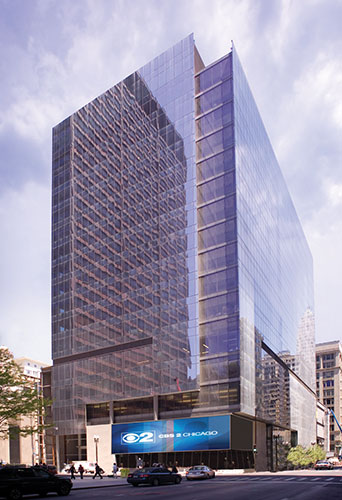Energy Awareness Brings Savings During COVID-19
As commercial real estate owners face budget constraints, rediscovering efficient energy infrastructure paints a silver lining.
As we settle into fall, some U.S. employees are being summoned back to the office. Physical occupancy in office properties was at 25 percent as of Sept. 9, according to data collected by Kastle Systems in 10 large U.S. cities. Most people are continuing to work from home, however, many with no return date in mind. In fact, when a viable COVID-19 vaccine is finally rolled out, some might discover they have no office to return to, with companies rethinking whether they need a physical base at all. Facing this turn of events, property owners and managers are prioritizing energy efficiency as they grapple with fluctuating consumption levels.
READ ALSO: Success of the Post-COVID-19 Office Hinges on Facilities Decisions
“Managing occupied, partially occupied and unoccupied spaces with cooling, heating and lighting is essential,” said Barry Wood, LEED accredited professional & director of retail operations at JLL. “Many tenants will not fully reoccupy, and owners and managers must be able to adjust and adapt their energy usages to the needs of the building and tenant.”

Built in 2008, 22 West Washington is one of Chicago’s trophy assets. The 17-story, 439,434-sq.ft. commercial property was designed by architecture firm Perkins + Will with high speed (minimal wait time) elevators; 14-inch raised floors for power, data and tenant-designed HVAC; digitally controlled, high capacity HVAC; and open floor plans that can be modified to meet social distancing protocols. Image courtesy of Colliers International
According to Wood, improving energy efficiency is a differentiator in most buildings because utilities typically rank in the top five for expenses. “Also, because of COVID-19, many buildings are seeing that rental income and expense recoveries are down, and owners and managers must be creative in managing the balance of the property needs. Maintaining conveniences to the tenants and guests coming to the property is essential to ensure they are comfortable being there.”
Best practices depend on the facility, but Wood said they will certainly include varying the set points on chillers and rooftop equipment; ensuring the operation of chillers, cooling towers, air handlers and roof op equipment is within the highest efficiency zone; and working with tenants to cluster workers—within CDC suggested guidelines—for lighting and cooling efficiencies.
Additionally, properties should stagger schedules to take advantage of natural daylighting. Another item on the list is the revision of settings on occupancy sensors for lighting and cooling in walk-through traffic areas as well as individual offices that may have shorter stay times.
READ ALSO: Sustainable Office Design Trends to Watch in 2020
It will be a challenge to obtain the same capital improvement dollars as before. Wood said, “To be approved for this type of project at properties, many owners will focus this capital money on ‘must do’ or ‘re-tenanting’ projects rather than operating efficiencies, therefore the building operations and engineering team will be essential in finding savings through operating efficiencies.”
Monitoring energy usage
Technology is bringing big advances in monitoring energy usage, but adoption has been sluggish. However, since COVID-19 has pushed up operating costs, having an efficient building has become sexy in the minds of owners. Energy consultants offering audits, such as Bright Power, have the receipts to prove that energy monitoring does save money and can reduce carbon emissions.
“When stay-at-home orders began, we saw our office and higher education clients’ building staff adjust equipment schedules to reflect the new reduced occupancy schedules,” said Samantha Pearce, director of energy management services at Bright Power. Clients that had action plans—or were able to easily prepare plans based on what equipment was essential for limited occupancy—are saving more.
READ ALSO: Electricity Consumption Plummets Following Pandemic Restrictions
According to Pearce, the best tip to offer is finding out how your equipment is operating, and how to adjust settings quickly and efficiently. “Remote monitoring and energy management services are an impactful way to mitigate the impact of COVID-19 on maintenance and operations plans.”
We had a client who needed to switch from heating to cooling at their building. We were able to walk them through the switch remotely since we had installed a remote monitoring system before the stay-at-home order. And, we were able to verify that the switch happened correctly, rather than have the property staff wait for resident complaints or before receiving increased utility bills,” she said.
Since the pandemic began, virologists have been preaching for bringing in as much outside air as possible. Doing this during mild weather can actually improve efficiency; for example, by utilizing the spring outdoor air to lower the temperature in a crowded auditorium instead of using a cooling tower. However, during extreme weather, increasing outdoor air can bring a drop in efficiency. In both cases, the outcomes depend greatly on the site’s mechanical equipment.
“It becomes extremely important to know how to capture those savings (during mild weather) in order to possibly counter the potential increased costs of increasing outdoor air supply during the extreme weather seasons,” Pearce said.
New operational guidance
Commercial buildings sitting vacant since March are significantly less energy efficient and more expensive to operate. According to Jeff Gerwig, LEED green associate & national engineering manager for Colliers International U.S., the reason is new operational guidance from the American Society of Heating, Refrigeration and Air-Conditioning Engineers (ASHRAE) during the pandemic. ASHRAE’s new standards help create healthier indoor environments. However, energy efficiency measures implemented for years are now being reversed to achieve the recommendations.
“The primary impacts on energy efficiency and operating costs have been centered around three items,” explained Gerwig. “First, the increase of HVAC operating hours—ASHRAE recommends increasing building operating hours, if possible, up to 24/7. Also, outdoor air dampers are being opened to maximum percentages allowable to bring more outdoor air inside the property and create higher demand for HVAC operations.”
ASHRAE also recommends that dampers be opened up to 100 percent if possible, and Demand Control Ventilation (DCV) be disabled. “This technology worked in conjunction with outdoor air dampers. It measured indoor pollutant concentrations and used precise amounts of outdoor air to maintain spaces.” Gerwig added, “Given that ASHRAE recommends outdoor air percentages be increased to highest levels possible, these devices are being disabled.”
Creating safe, healthy environments
Employees are bound to continue reoccupying buildings in coming months, providing an excellent opportunity to consider both air quality and whether buildings are on track with long-term sustainability or efficiency goals.
“The types of air quality requirements we’re seeing put in place are very dependent on both the region/state and the type of building and can have a variety of implications on energy efficiency,” said Lou Maltezos, executive vice president of Ameresco, a company that specializes in renewable energy and energy efficiency consulting.
“As building owners have considered and experienced what ‘back to work’ looks like in communities around the world, we’re seeing a number of customers consider items such as touchless controls, updated HVAC systems and automated entry/exit systems to address both the efficiency needs of the building and the health and safety of the occupants,” Maltezos added.
For example, with the correct process and tenant instruction in place, owners can implement technologies such as ionization to their outside air units in return ducts that may reduce the amount of air needed to condition a space. Maltezos added that efficiency relies on utilizing data not only from the space, but the air handlers and controls system as well, for providing the correct amount of outside air.
Rethinking priorities
In the current climate, it is essential to stay in touch with thought leadership on all matters related to energy. “Unfortunately, in most cases the energy savings reported (since COVID-19) for most buildings are not as significant as expected and not in line with occupancy reductions,” weighed in Thomas Vazakas, Cushman & Wakefield associate director of energy, infrastructure and sustainability for the EMEA region. “This is due to the inability in most buildings to have effective controls and zoning.”
For example, heating and cooling is provided to all open plan areas, whether occupied or not. Similarly, in many cases there are no occupancy sensors for lighting, therefore most, if not all, the lights will be on even though only a small area of the office needs it.
“As a result, we see most buildings using very similar energy to heating, cooling or lighting even though their occupancy is 50-90 percent less than it used to be,” explained Vazakas. “This is a great opportunity to install adequate controls in our buildings to ensure no energy is wasted.”
READ ALSO: Why Green Leases Will Bloom After the Pandemic
As the effects of the health crisis unfold, owners and managers continue testing in resilience. “Surely the loss of human lives is devastating, but at the same time COVID-19 presents an opportunity to rethink our priorities and change the way we live—and how we use our buildings. Many property owners are already looking into this and trying to use this crisis to help them develop and implement their sustainability goals and especially their corporate plans to meet Net Zero Carbon,” Vazakas concluded.
When this agenda also results in operational savings, it’s icing on the cake.








You must be logged in to post a comment.